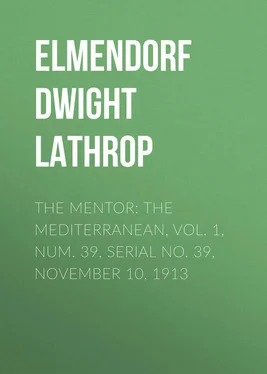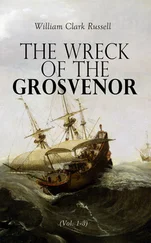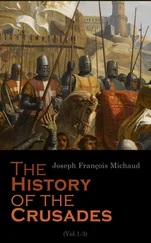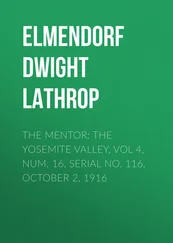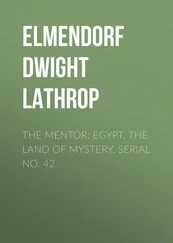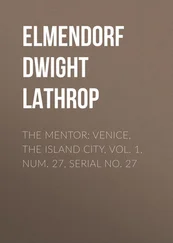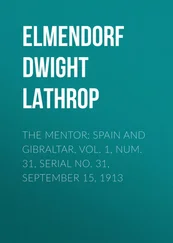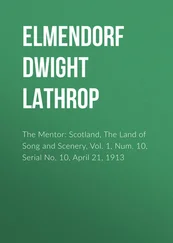Dwight Elmendorf - The Mentor - The Mediterranean, Vol. 1, Num. 39, Serial No. 39, November 10, 1913
Здесь есть возможность читать онлайн «Dwight Elmendorf - The Mentor - The Mediterranean, Vol. 1, Num. 39, Serial No. 39, November 10, 1913» — ознакомительный отрывок электронной книги совершенно бесплатно, а после прочтения отрывка купить полную версию. В некоторых случаях можно слушать аудио, скачать через торрент в формате fb2 и присутствует краткое содержание. Жанр: foreign_antique, foreign_prose, на английском языке. Описание произведения, (предисловие) а так же отзывы посетителей доступны на портале библиотеки ЛибКат.
- Название:The Mentor: The Mediterranean, Vol. 1, Num. 39, Serial No. 39, November 10, 1913
- Автор:
- Жанр:
- Год:неизвестен
- ISBN:нет данных
- Рейтинг книги:5 / 5. Голосов: 1
-
Избранное:Добавить в избранное
- Отзывы:
-
Ваша оценка:
- 100
- 1
- 2
- 3
- 4
- 5
The Mentor: The Mediterranean, Vol. 1, Num. 39, Serial No. 39, November 10, 1913: краткое содержание, описание и аннотация
Предлагаем к чтению аннотацию, описание, краткое содержание или предисловие (зависит от того, что написал сам автор книги «The Mentor: The Mediterranean, Vol. 1, Num. 39, Serial No. 39, November 10, 1913»). Если вы не нашли необходимую информацию о книге — напишите в комментариях, мы постараемся отыскать её.
The Mentor: The Mediterranean, Vol. 1, Num. 39, Serial No. 39, November 10, 1913 — читать онлайн ознакомительный отрывок
Ниже представлен текст книги, разбитый по страницам. Система сохранения места последней прочитанной страницы, позволяет с удобством читать онлайн бесплатно книгу «The Mentor: The Mediterranean, Vol. 1, Num. 39, Serial No. 39, November 10, 1913», без необходимости каждый раз заново искать на чём Вы остановились. Поставьте закладку, и сможете в любой момент перейти на страницу, на которой закончили чтение.
Интервал:
Закладка:
Dwight L. Elmendorf
The Mentor: The Mediterranean, Vol. 1, Num. 39, Serial No. 39, November 10, 1913
Across the straits from Gibraltar is another and very different world. Start with Tangier (tahn-jeer´) and wander along the Barbary coast, and you will find yourself in such contrasting conditions, and in a civilization so different from those north of you in Spain and in France, that it will be hard for you to believe that you are separated from those countries by distances varying from the narrow straits of Gibraltar to a mere matter of two or three hundred miles.
You will seem to have been transported to the other side of the world. No traveler can find greater variety in scene and life, in language and habit, in climate and condition, than he gets in the course of a full Mediterranean tour. Few travelers make the whole circuit of the Mediterranean. This great inland sea is usually visited only in parts, and while the traveler is in transit from one point to another. There is no general description that can apply to the whole of this interesting body of water. On every shore there is something that is new and different, and somewhere on these shores there is something to delight each one. If scenery is desired, the French and Italian Riviera (ree-vee-ay´-rah) will draw one irresistibly. A life full of gaiety will hold him there. If historic associations interest him, he will turn naturally to the shores of Italy and Greece, and he will spend months pleasantly in the Adriatic or Ægean Sea. There is in those countries an endless amount to learn and a wealth of natural beauty. When you have cruised through the Ægean (ee-jee´-an), visit the coast of Greece, and of Asia Minor. There you will know the feelings that stirred Lord Byron when he wrote:
“Fair clime! where every season smiles
Benignant o’er those blessed isles,
Which seen from far Colonna’s height,
Make glad the heart that hails the sight,
And lend to loneliness, delight.”
The Mediterranean has been the arena of the world’s history for several thousand years.
As your eye traces the coast line on the map and you note the countries whose shores are washed by the Mediterranean, you realize what a trip throughout that sea must mean in instruction as well as in delights of travel. Besides the countries I have named, there are Turkey, Asia Minor, Palestine, and Egypt, to say nothing of the great stretch on the African coast. The shore line is so extended, and the life and customs at different points vary so, that we think of the Mediterranean as not one thing, but many things. What is usually called a “Mediterranean trip” rarely comprises more than ten or fifteen points. With limited time, the traveler naturally selects the points of which he has heard most.
A Mediterranean trip to many travelers means Algiers (al-jeerz´), as far as the African coast is concerned, and the Riviera, with all the points on that beautiful north shore line. Then they must see Naples, of course, and after passing down the Italian coast they are likely to go straight on to Egypt. After passing through the straits of Gibraltar the attention of the traveler is soon centered on Algiers.
From the entrance to the harbor Algiers appears like a white diamond set in a circle of emeralds. The town consists of two parts, the French and the Arab quarters. To the visitor from the west Algiers is most interesting; for there he meets characters of all kinds, European peoples mixing with those of North Africa. The French quarters show that the Frenchman, when compelled to live in another country, takes a bit of Paris with him; for there is found the typical French café, with its little tables on the sidewalk, contrasting with the Arab café where natives, in their picturesque white costumes, sit and sip their coffee and gossip with wild gesticulation. Even in its African population Algiers is oddly mixed. Each tribe has its own peculiar costume, the marketplace often looking like a stage of a comic opera, only much more artistic and natural.
The government house, and in fact all the buildings except those in the French quarters, are Moorish in design and generally whitewashed, so that they masquerade as glittering white marble. The town is beautifully situated, and is surrounded by a very interesting country filled with relics of Punic War times, and ruins of structures of even a more remote period. Near Algiers is the building called the “tomb of the Christian woman.” This is really the tomb of Juba II, who married Cleopatra Selene (se-lee´-nee), daughter of the celebrated Cleopatra and of Marc Antony. Juba II had a son, Ptolemy, and a daughter, Drusilla, who was the wife of Felix, procurator of Judea, who, it will be remembered, said to Saint Paul, “Go thy way for this time; when I have a convenient season, I will call for thee” (Acts xxiv, 25).
All the coast about Algiers is filled with just such interesting relics of Biblical times. Perfect French roads now make it possible to reach the most interesting places by carriage or motorcar.
Across the Mediterranean is a stretch of shore that no traveler in Europe should miss. It is called “The Riviera,” and it extends from Cannes (kahn) to Ventimiglia (ven-tee-meel´-yah), thence to Spezia (spet´-see-ah), beyond Genoa (jen´-o-ah); the former section French, the latter Italian. From one end to the other is a chain of health resorts, some most fashionable, others the very opposite; the latter on that account more desirable to those who wish peace and quiet. Even in the most retired spots, however, there is no escape from the honk-honk of the motorcars; for Riviera highways are the favorite touring roads of southern Europe.
Beginning at Cannes, the necklace of the sea contains such jewels as Antibes (ong-teeb´), Nice (nees), Villefranche-sur-Mer (veel-frongsh-soor-mare´), Beaulieu (bo-lee-eh´), Monaco (mon´-ah-ko), Monte Carlo, and Mentone (men-to´-ne). These are followed by the Italian section, – Ventimiglia, Bordighera (bor-dee-gay´-rah), Ospedaletti, San Remo (ray´-mo), Alassio (ah-lahs´-see-o), Savona (sah-vo´-nah), Pegli (pel´-yee), and Genoa. This section is called the Riviera di Ponente (po-nen´-teh), followed by Riviera di Levante (le-vahn´-te) to the east of Genoa, – Nervi (ner´-vee), Recco (rek´-ko), Santa Margherita Ligure (lih-goor´-eh), Rapallo (rah-pahl´-lo), Sestri Levante, and Spezia.
The French section is more fully developed, and therefore more comfortable and fashionable. The Italian section, while beautiful, leaves much to be desired by the ordinary tourist.
There nestles in the southeast corner of France a tiny little principality called Monaco, the most remarkable place of its kind in the world.
It is only about eight square miles in area, and contains nineteen thousand inhabitants. Strange as it may seem, there are no taxes there, as the Société des Bains de Mer, which is simply a name for the society or company that runs the Casino gambling tables at Monte Carlo, pays the tribute. From the millions of francs paid by this society to the Prince of Monaco and his government every year, the natural inference is that most of the visitors to Monte Carlo get nothing except experience.
The Casino building is very theatrical in style, built expressly for its purpose, and superbly placed on a promontory overlooking the sea and town. It is surrounded by beautiful gardens, carefully kept. In fact, the whole place is a delight to the eye and the most beautiful spot on the Riviera. It is attractive enough to detain one for days, even if the great magnet, the Casino, were not there. On account of the gaming, the whole district is filled with characters that one had rather not meet except in the Casino, where perfect order is assured by the presence of numerous detectives, ready to check disorder when it threatens, or to notify politely anyone of suicidal tendency to leave the Casino and the principality. There is no place in the world where arrangements are so well planned to satisfy the desire of human beings to get something for nothing. And it is not simply a gaming place. The spectacle of Monte Carlo has a great fascination even for those who never play at the tables, everything is so beautiful, so orderly, and so well kept. Many who visit there prefer, however, to stop at Mentone, which is but a few minutes distant by trolley or motorcar.
Читать дальшеИнтервал:
Закладка:
Похожие книги на «The Mentor: The Mediterranean, Vol. 1, Num. 39, Serial No. 39, November 10, 1913»
Представляем Вашему вниманию похожие книги на «The Mentor: The Mediterranean, Vol. 1, Num. 39, Serial No. 39, November 10, 1913» списком для выбора. Мы отобрали схожую по названию и смыслу литературу в надежде предоставить читателям больше вариантов отыскать новые, интересные, ещё непрочитанные произведения.
Обсуждение, отзывы о книге «The Mentor: The Mediterranean, Vol. 1, Num. 39, Serial No. 39, November 10, 1913» и просто собственные мнения читателей. Оставьте ваши комментарии, напишите, что Вы думаете о произведении, его смысле или главных героях. Укажите что конкретно понравилось, а что нет, и почему Вы так считаете.
